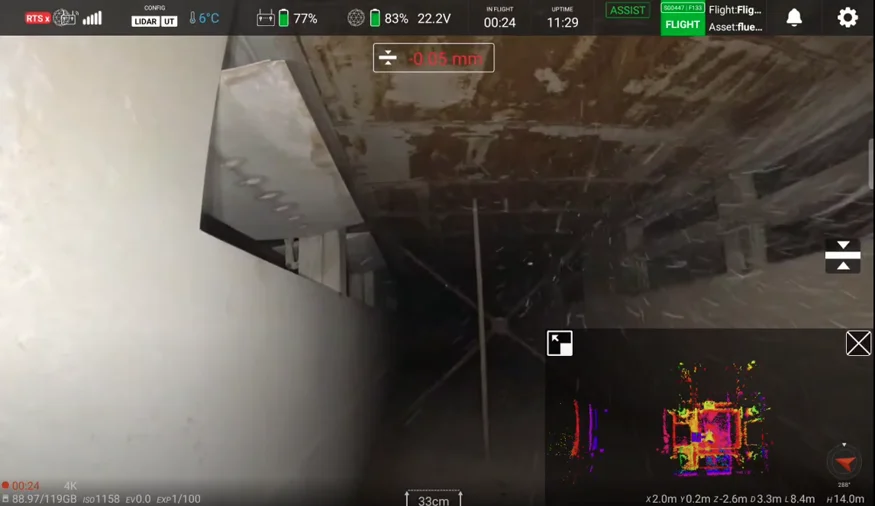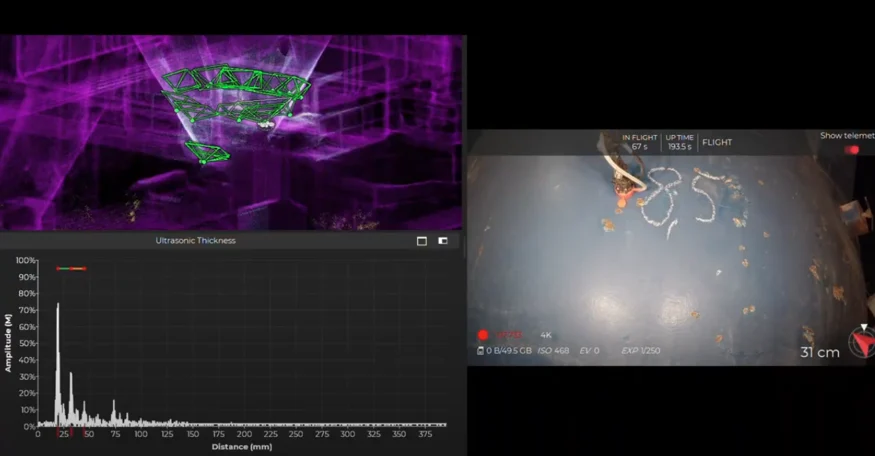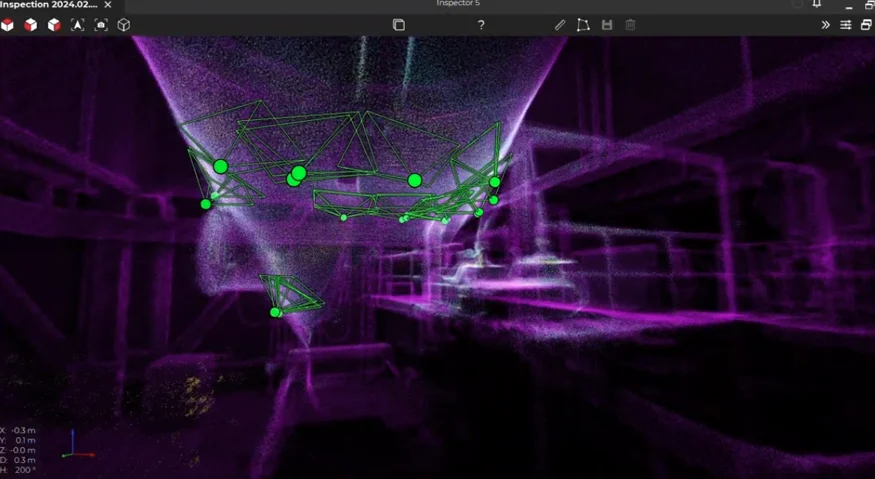UT Drone Inspections at a Cement Plant
UT Drone Inspections at a Cement Plant
Key Benefits in Brief
|
Access |
Speed With the Elios 3, inspections were significantly faster than conventional methods, enabling multiple large assets to be checked within a single day. |
|
Safety Utilizing a UT drone for inspections eliminates the need for scaffolding and rope access, greatly reducing risks to personnel. Â |
Data Quality The Elios 3 collects precise UT spot measurements inside assets to meet industrial inspection standards, supporting digital asset management. |
A cement plant relies on seamless connections across its facilities, from the quarry to the crusher, mills to the kiln, and clinkers to silos. Each component is meticulously maintained by plant managers to minimize disruptions when assets are temporarily or completely out of service.Â
Inspections play a critical role in maintaining the production efficiency of a cement plant. Often, visual inspections are supplemented by non-destructive testing methods, including ultrasonic thickness (UT) measurements, to assess the condition of specific assets.Â
However, accessing all these assets isn’t always straightforward. Many times, scaffolding or rope access is required to reach higher structures, which is time-consuming and poses risks to staff. Nowadays, the Elios 3 and its UT payload offer a safer, more efficient inspection alternative.
Moving Toward UT Drone Inspections in Industry
The Elios 3 is a specialized UT drone designed to access complex and confined spaces without putting people at risk. By flying inside stacks or silos, the drone can gather essential data needed to certify the condition of assets and identify potential maintenance issues early.Â
InspecDrone, a German inspection firm, participated in testing the new UT payload for the Elios 3 drone. As part of this effort, they visited a cement plant to inspect assets and showcase to the site owners how the drone could streamline and enhance inspections.
Inspecting Assets with the Elios 3 UT Drone
1. Flue Duct
The first asset to be inspected was a flue duct. This duct transitions from a rectangular shape at one end to a more rounded form further along. The rectangular section had been partly replaced, and the client aimed to assess the degradation of the remaining steel. Since this duct transports air and dust up to 300°C from the raw mill to a filter, it is both hot and corrosive. Monitoring the duct's condition is crucial because any failure would be hard to repair and could halt a significant portion of plant operations.Â
This duct is particularly challenging to inspect using traditional methods. Its insulation and bending structure require inspection from within. At 50 meters tall, with only one open end due to a fan system, confined space inspections with humans are severely restricted. Complying with confined space entry regulations might necessitate opening the fan casing. Typically, a team of three or more workers is involved: one climbing with rope access, another monitoring safety, and a third assisting the climber. Preparing ropes, safety protocols, and permits often takes at least a day, not counting the time to collect data. Thus, even a small section of this flue duct is tough to inspect.

The Elios 3 and its UT payload navigated the flue duct despite dust and its complex shape
With the Elios 3, everything became simpler. The drone entered the duct and flew through the targeted rectangular area under the control of a single pilot. The entire inspection took less than two hours.Â
For this type of inspection, it’s usual to take five UT measurements per meter, plus additional spot measurements at key points of interest. Given the Elios 3’s clear visual data, it was easy to pinpoint interesting spots for extra A-scans. During four flights inside the duct, the Elios 3 pilot gathered over 20 measurements per flight, examining the initial few meters inside the duct.Â
InspecDrone’s swift inspection earned them permission to conduct demonstration UT inspections on other assets. Site managers accustomed to traditional methods were astonished by how quickly the Elios 3 UT completed inspections, providing both visual and ultrasonic data.
2. Silo Cones
The Elios 3 was next tasked with inspecting the cones of limestone silos. These large steel structures were housed inside a warehouse. Without insulation on the silos, it was possible to measure from the outside rather than the inside. However, they were elevated several meters off the ground, complicating UT measurements since access would require scaffolding or mobile elevated work platforms. Despite the logistical challenges, these inspections are vital because the cones experience high wear and tear.
Inspecting six silos with traditional scaffolding methods would likely cost several thousand euros, involve hours of planning, material transport, and require numerous measurement points per silo. Previous UT measurements had been noted with chalk markings on the silos, which is neither precise nor reliable for tracking changes over time.

The Elios 3 inspected the silo cones alongside existing chalk markings
On the other hand, the Elios 3 with its UT payload completed UT surveys effortlessly. Within one to two flights per silo, the drone measured 25-30 points. All of this was done by a single pilot, contrasting sharply with the labor-intensive scaffolding process. Moreover, the Elios 3 UT provides results in a digital format that are geolocated onto the asset. This ensures not only the UT measurement but also its exact location, allowing future inspections to use the same points and simplify calculating wear rates and monitoring the asset’s condition over time.
Additionally, the Elios 3 pilot had the opportunity to inspect ducts located in the roof of the building. These ducts are difficult to access and are usually only serviced when something unusual happens, like a strange noise or visible defect. With the Elios 3, it became possible to conduct brief inspections and gain an overview of the smaller ducts’ conditions. This data was previously unavailable, yet the Elios 3 UT managed to gather it in minutes, alongside the silo inspections and flights inside the flue duct.
Unveiling Enhanced Inspection Possibilities with Drones
The speed, safety, and superior access provided by the Elios 3 UT in a single day at this cement plant highlighted the transformative impact the Elios 3 can have on inspection processes. Instead of relying on methods that involve days of planning, special permissions, and prolonged downtime, the Elios 3 UT collected data quickly and safely.Â

Quality of results: with the Elios 3 UT, it’s simple to localize and record UT points ready for analysis later in Inspector 5
Beyond this, the access the drone offers can improve the overall functioning of the site. Faster inspections enable more frequent checks, allowing preventive maintenance rather than reactive responses due to cost or downtime concerns. This marks a significant leap forward in optimizing plant operations, offering long-term savings through drone use rather than one-time benefits. It opens the door to increased productivity without compromising safety or integrity.
InspecDrone’s client was so impressed that they expressed interest in learning more about the Elios 3 UT drone’s applications for inspecting other assets on-site. From the flue duct to the silos and the smaller duct systems, the Elios 3 clearly demonstrated that inspections don’t have to be cumbersome or complex—they can be swift while maintaining data quality.
Â
The steel angle is a carbon structural steel for construction. It is section steel with a simple cross-section. It is mainly used for metal components and the frame of the workshop. It is required to have good weldability, plastic deformation performance and certain mechanical strength in use. The raw steel billet for the production of angle steel is a low-carbon square billet, and the finished angle steel is delivered in the form of normalized or hot rolled.
Steel angle bar can be made into pressure structural bracket based on different size and grade, and also can be made into connector between structural beam. Widely used for various building structures and engineering structures, such as house beams, bridges, power transmission towers, lifting, and transportation machinery, ships, industrial furnaces, reaction towers, container racks, cable trench brackets, power piping, busbar bracket installation, and warehouse shelves.
Equal and unequal are the two major types of steel angle:
Steel angles are fashioned using a single Flat Steel section and bending it, generally at a 90-degree angle with both legs the same size. See below for a rundown of the different steel angle types:
Equal angle
Equal steel angles have 2 axes` that are the same length, hence their name. They are the most common types of steel section and can be made to various specs and cut to any size, making them extremely versatile. Their sizing is represented by side A x side B x thickness.
Unequal angle
Unequal steel angles are also right-angled; however, they have different sized axis` making them L-shaped. This section is much stronger (up to 20%) with a much higher strength to weight ratios. Their sizing is represented by side A x side B x thickness.
Steel Angle Bar,Steel Angle,Angle Iron,Mild Steel Angle Bar,Galvanized Steel Angle Bar
Tianjin YF Steel Co., Ltd , https://www.youfametal.com